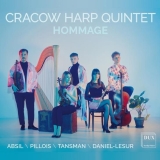Ist dies nun eine Hommage an die Kammermusik aus der ersten Hälfte des 20. Jahrhunderts oder eine Hommage an die Harfe? Beides ist möglich und stimmig, gemeint ist jedoch das Quintette instrumental de Paris, gegründet 1922 vom Harfisten Pierre Jamet. Sämtliche Werke wurden dem Ensemble auf Maß geschrieben, und die Harfe darf für einmal aus ihrem Glissandi-Cliché schlüpfen.
Das Programm beginnt mit dem kurzen Concert à cinq von Jean Absil, aufrüttelnd und ausdrucksstark interpretiert im ersten Satz, poetisch aufgehellt im Andante.
Jacques Pillois’ Cinq Haï-kaï spielen die fünf Musiker zart und feinfühlig mit einem schönen asiatischen Kolorit, wohingegen Alexandre Tansmans Sonatina da camera sehr spannungsgeladen ist und wiederholt mit emotionalen Eruptionen aufhorchen lässt.
Abgerundet wird das Programm mit Jean-Yves Daniel-Lesurs Suite médiévale – wiederum ein ganz anderes Klangspektrum zum Teil erinnernd an gregorianische Gesänge. Auch hier trifft das Cracow Harp Quintet den passenden Ton, und es ist gerade die klangliche Vielfalt, das fein aufeinander abgestimmte, gemeinsame Musizieren, das dieses Album zu einem Erlebnis lassen wird.
Is this now a homage to chamber music from the first half of the 20th century or a homage to the harp? Both are possible and coherent, but what is meant is the Quintette instrumental de Paris, founded in 1922 by harpist Pierre Jamet. All the works on this CD were written for this ensemble, and for once the harp is allowed to slip out of its glissandi cliché.
The program begins with the short Concert à cinq by Jean Absil, stirring and expressively interpreted in the first movement, poetically brightened in the Andante.
Jacques Pillois’ Cinq Haï-kaï is played by the five musicians delicately and sensitively with a beautiful Asian color, whereas Alexandre Tansman’s Sonatina da camera is very suspenseful and repeatedly makes one sit up and take notice with emotional eruptions.
The program is rounded off with Jean-Yves Daniel-Lesur’s Suite médiévale – again a completely different sound spectrum, in part reminiscent of Gregorian chants. Here, too, the Cracow Harp Quintet hits the right note, and it is precisely the tonal variety, the finely tuned, collaborative music-making that will make this album an experience.
























